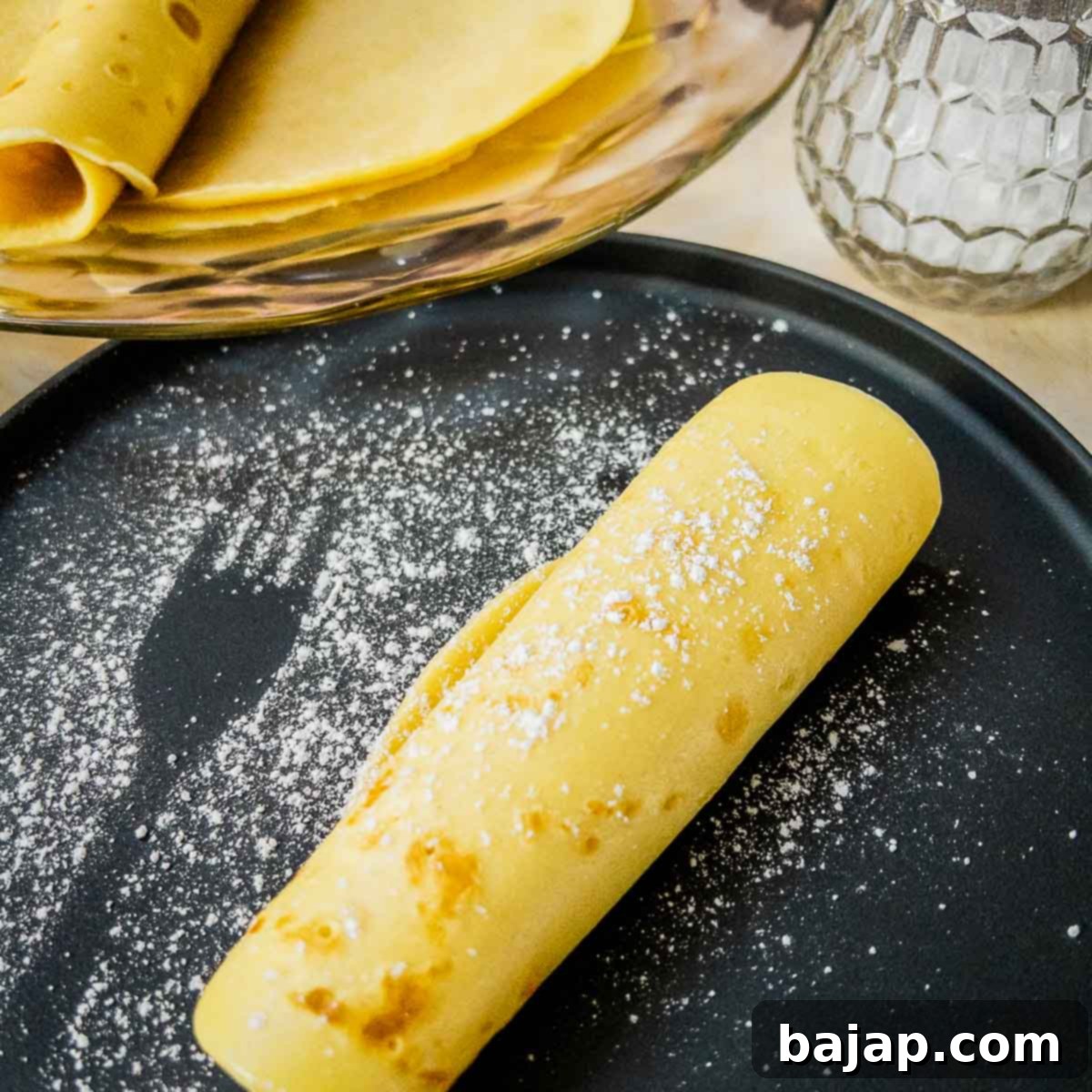Authentic Austrian Palatschinken with Apricot Jam: A Classic Thin Pancake Recipe
Step into the delightful world of Austrian cuisine with our easy-to-follow recipe for Palatschinken with Apricot Jam. These delicate, thin pancakes, often compared to French crêpes, are a beloved classic in Austria, particularly in the enchanting city of Vienna. Generously filled with a layer of sweet, tangy apricot jam and traditionally dusted with a cloud of powdered sugar, they make for an exquisite dessert, a comforting breakfast, or a delightful afternoon treat. The preparation is surprisingly simple, allowing you to whip up this charming delicacy in no time and bring a taste of Austrian tradition right to your kitchen!
For those who wish to enhance the taste of the apricot jam and add a sophisticated twist, you can introduce a subtle dash of rum. This optional addition brings a warm, aromatic depth that beautifully complements the fruitiness of the apricots, transforming a simple filling into something truly special. It’s a classic Austrian touch that adds an extra layer of flavor complexity, making your homemade Palatschinken even more authentic and memorable.
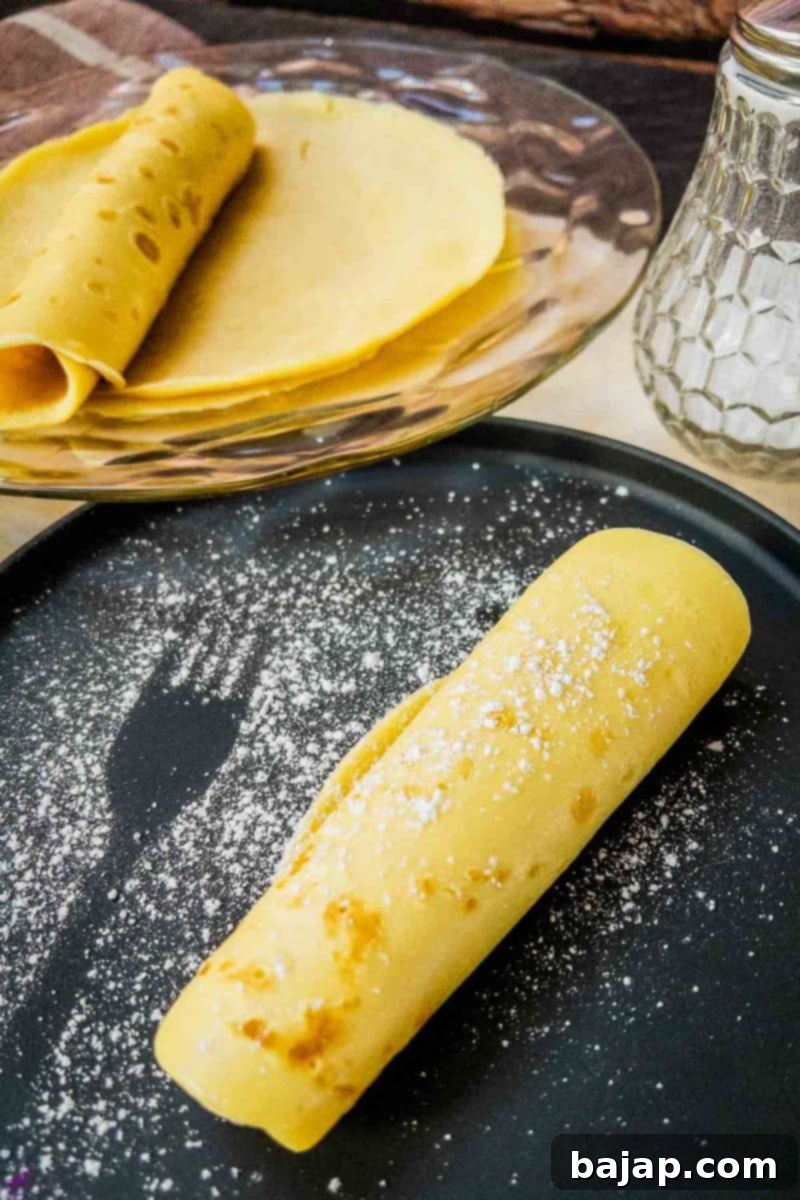
While you’re exploring the delightful versatility of pancakes, don’t miss our indulgent ice cream pancakes. They are particularly delightful when paired with rich homemade vanilla ice cream, offering a decadent variation that’s definitely worth a peek!
Mark your calendars: September 26th is National Pancake Day! What better way to celebrate than by whipping up a batch of these traditional Austrian treats?
Jump to Sections:
- What are Palatschinken? The Austrian Crêpe!
- Ingredients for Perfect Apricot Palatschinken
- Step-by-Step Instructions: How to Make Palatschinken
- Delicious Variations on Palatschinken
- Essential Equipment for Palatschinken
- Storage Tips for Your Palatschinken
- Expert Tips for Frying and Turning Pancakes
- Frequently Asked Questions about Palatschinken
- Recipe Card
- Food Safety Guidelines
What are Palatschinken? The Austrian Crêpe!
If you’ve ever found yourself wandering through the charming streets of Vienna or any other part of Austria and heard the word “Palatschinken,” you might have wondered what culinary delight it refers to. Well, now you know: it’s the beloved Austrian term for these wonderfully thin pancakes! Understanding this local term is a fun and useful tidbit, especially if you plan a culinary adventure to Austria. It’s deeply intertwined with the rich cultural tapestry of Austrian cuisine.
While often compared to French crêpes due to their similar thinness and delicate texture, Palatschinken hold a unique and cherished place in the hearts of Austrians. The name itself has a fascinating linguistic journey, believed to have originated from the Latin word “placenta” (meaning “flat cake”). This evolved through Romanian (“plăcintă”) and Hungarian (“palacsinta”) before firmly establishing itself in Austria. This etymology perfectly illustrates the historical culinary exchange and influence across Central European cultures, showcasing how a simple dish can connect diverse regions.
It’s important to note the distinction from German “Pfannkuchen,” a term which, to the chagrin of many a proud Viennese, is often incorrectly used to describe Palatschinken. German “Pfannkuchen” are typically thicker, fluffier, and more akin to American pancakes, while Palatschinken are specifically defined by their delicate, almost translucent thinness and elegant rollability. So, remember, when you’re in Austria and ordering this sweet treat, it’s always “Palatschinken” – a name that truly captures the unique charm and culinary heritage of this delightful dessert! 😄
🥘 Ingredients for Perfect Apricot Palatschinken
Crafting the ideal Palatschinken begins with a careful selection of fresh, high-quality ingredients. Each component plays a crucial role in achieving that perfect thin texture and delightful flavor profile that makes Austrian Palatschinken so special. Here’s a closer look at what you’ll need and why each element is important:
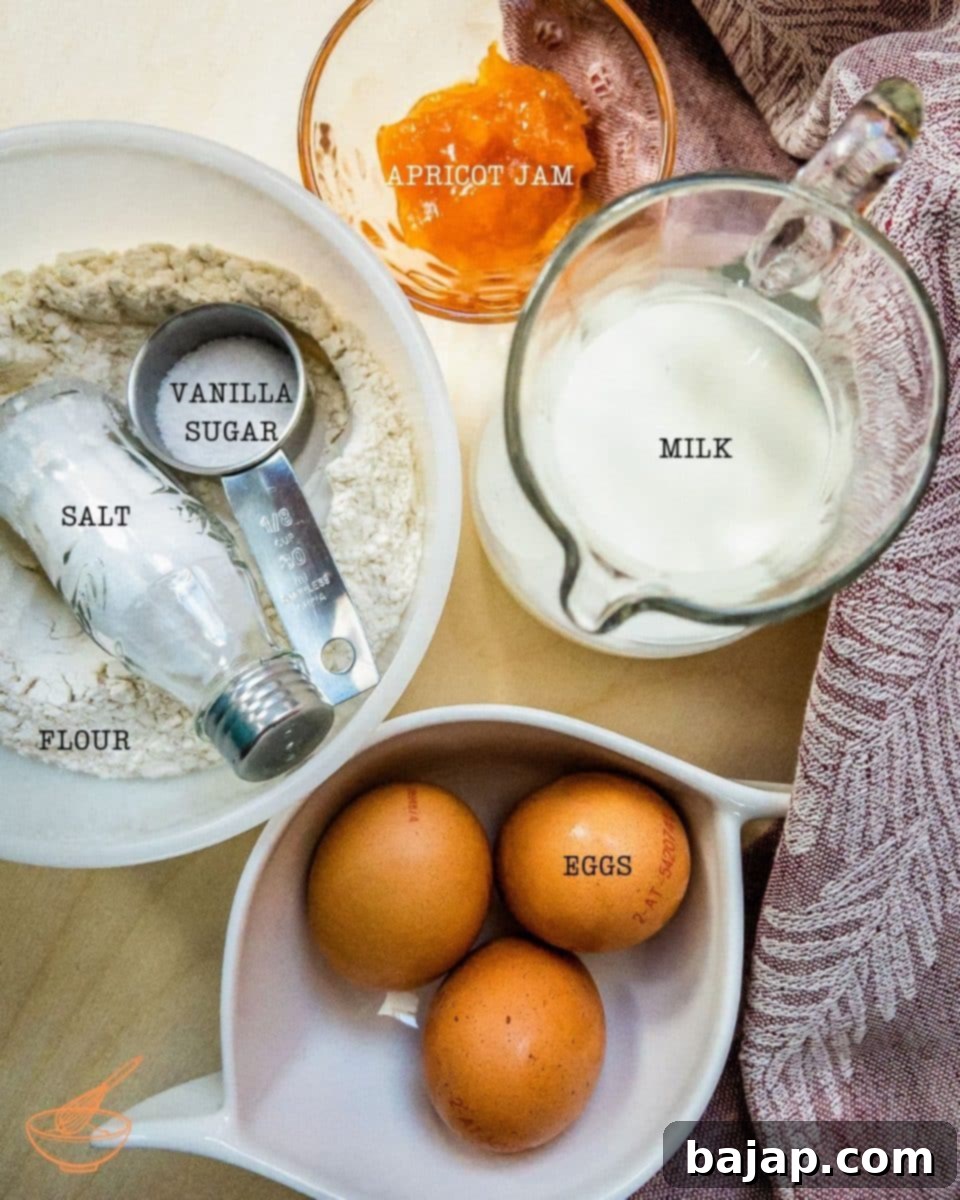
- Flour: All-Purpose Flour or a fine pastry flour is recommended. Its moderate protein content ensures a tender, delicate pancake that won’t become tough or chewy, providing the perfect base for these thin treats.
- Eggs: Essential for providing structure and richness to the batter. The eggs bind the ingredients together, contributing to the thin yet pliable texture that allows the Palatschinken to be easily rolled without tearing.
- Yolks: Adding an extra egg yolk not only boosts the richness and flavor but also contributes to a beautiful golden color of the cooked Palatschinken, making them even more visually appealing.
- Vanilla Sugar: A traditional and beloved Austrian ingredient, vanilla sugar infuses the pancakes with a delicate, sweet vanilla aroma. You can easily find store-bought packets or, for an even fresher flavor, make your own homemade vanilla sugar. If unavailable, a teaspoon of good quality vanilla extract can be substituted.
- Kosher Salt: A small pinch of salt is vital. It doesn’t make the pancakes salty but rather balances the sweetness of the sugar and jam, enhancing the overall flavor profile of the dish.
- Milk: This liquid forms the base of the batter, thinning it to the characteristic delicate consistency of Palatschinken. While any fat percentage milk works, whole milk will add a touch more richness and a creamier mouthfeel to your pancakes.
- Oil or melted Butter: A small amount of fat, either oil or melted butter, is added to the batter. This helps prevent the pancakes from sticking to the pan and contributes to their smooth, tender texture.
- Apricot Jam: The star of the filling! For the most authentic taste, opt for a high-quality, fine apricot jam. Austrian apricot jams (known as Marillenmarmelade) are particularly famous for their vibrant flavor and smooth consistency.
- Water or Rum: A dash of liquid is used to thin the jam slightly, making it wonderfully smooth and easy to spread across the delicate pancakes. Replacing the water with a dash of dark rum adds a wonderful depth of flavor and a subtle alcoholic kick, which is a classic Austrian pairing.
- Powdered Sugar: This fine sugar is indispensable for dusting the finished Palatschinken. It adds a beautiful, elegant finish and a final touch of sweetness that makes them irresistible.
For precise quantities and a printable version, please refer to the detailed recipe card below.
🔪 Step-by-Step Instructions: How to Make Palatschinken
Making these delicate Austrian pancakes is an enjoyable and rewarding process. Follow these detailed steps for perfect results every time, ensuring your Palatschinken are as authentic and delicious as those found in Vienna’s finest cafés:
Step 1 – Preparing the Thin Pancake Batter
Begin by combining the dry and wet ingredients to form your smooth Palatschinken batter. In a spacious mixing bowl, first add the flour, eggs, extra egg yolk, vanilla sugar, kosher salt, and a small portion of the milk. Whisk these together vigorously until you achieve a perfectly smooth consistency. For ease and efficiency, a food processor or an electric mixer works wonders, quickly eliminating lumps. However, a good old-fashioned whisk and some diligent hand mixing will also yield excellent results.
Gradually incorporate the remaining milk into the mixture, stirring continuously until the batter is very thin and completely free of any lumps. The hallmark of authentic Palatschinken is its incredibly fluid, almost watery consistency – it should be much thinner than what you would typically use for American-style pancakes, resembling heavy cream in pourability. If your batter appears too thick or dense, do not hesitate to thin it further with an additional splash of milk until you reach this delicate consistency. This ensures your finished pancakes will be wonderfully delicate, light, and easy to roll.
Once your batter is smooth and thin, a crucial step for truly flawless Palatschinken is to pass it through a fine-mesh sieve into another clean mixing bowl. This step effectively removes any tiny lumps or bits of unmixed flour that might have escaped your whisk, guaranteeing an incredibly silky-smooth pancake texture. After sifting, let the batter rest for at least 20 minutes at room temperature. This resting period allows the flour to fully hydrate, preventing the pancakes from tearing during frying and resulting in a much more tender and pliable final product. You can even prepare the batter in advance and let it rest in the refrigerator for up to an hour or overnight, just give it a quick whisk and potentially a little more milk before frying.
Step 2 – Frying the Delicate Palatschinken
Achieving perfectly fried Palatschinken requires the right equipment and a little practiced technique. A high-quality non-stick pan is absolutely essential here to prevent any sticking. While a regular coated frying pan will work effectively, specialized non-stick crêpe pans with their shallower edges can make the process of swirling the batter and flipping the pancakes even easier. Use whatever pan you have available that you are most comfortable with.
Place your chosen pan over medium heat. Add just a tiny drop of oil or a minute pat of melted butter – you genuinely don’t need much here. The goal is to lightly grease the pan for each pancake, not to fry it in excess oil. Too much fat will make your pancakes greasy and less delicate. Once the pan is properly hot (you can test this by flicking a tiny drop of water onto it; it should sizzle immediately and evaporate), pour a small ladleful of batter into the very center of the hot skillet.
Immediately and quickly swirl the pan, tilting it gently in all directions, to evenly coat the entire bottom surface with a very thin layer of batter. This quick swirling motion is absolutely vital for creating those characteristic thin and expansive Palatschinken. Don’t worry if it takes a couple of tries to get the amount of batter and the swirling technique just right – even seasoned cooks sometimes need a “practice pancake” or two to get back into the rhythm! Remember, the goal is a layer thin enough to see through slightly.
Cook the pancake for approximately 1-2 minutes per side, or until it turns a beautiful golden brown and the edges begin to crisp slightly and pull away from the pan. This indicates it’s ready to flip. Once flipped, cook the second side for a similar duration until it also achieves a lovely golden hue. As each Palatschinke is finished, transfer it to a plate and keep it warm in a very low oven (around 170°F/75°C) while you continue frying the remaining batter. This ensures all your pancakes are perfectly warm and ready for filling.
Step 3 – The Apricot Jam Filling and Assembly
Now, it’s time for the delicious apricot jam filling, the true heart of these Palatschinken! To prepare your filling, spoon the apricot jam into a small bowl. Add a dash of water to thin it slightly, making it more spreadable and ensuring it coats the pancakes beautifully. For an authentic and elevated flavor experience, consider replacing the water with a dash of dark rum. The rum adds a wonderful depth and aromatic warmth that pairs exquisitely with the sweet-tartness of the apricots, a truly classic Austrian combination. Stir well to ensure the jam is smoothly combined with your chosen liquid.
For an extra fine and smooth jam, especially if your apricot jam contains larger fruit pieces or skins, a quick step can make all the difference: press the thinned jam through a fine-mesh sieve. This ensures a silky-smooth consistency that is absolutely ideal for spreading evenly over your delicate, thin pancakes, creating a luxurious mouthfeel with every bite.
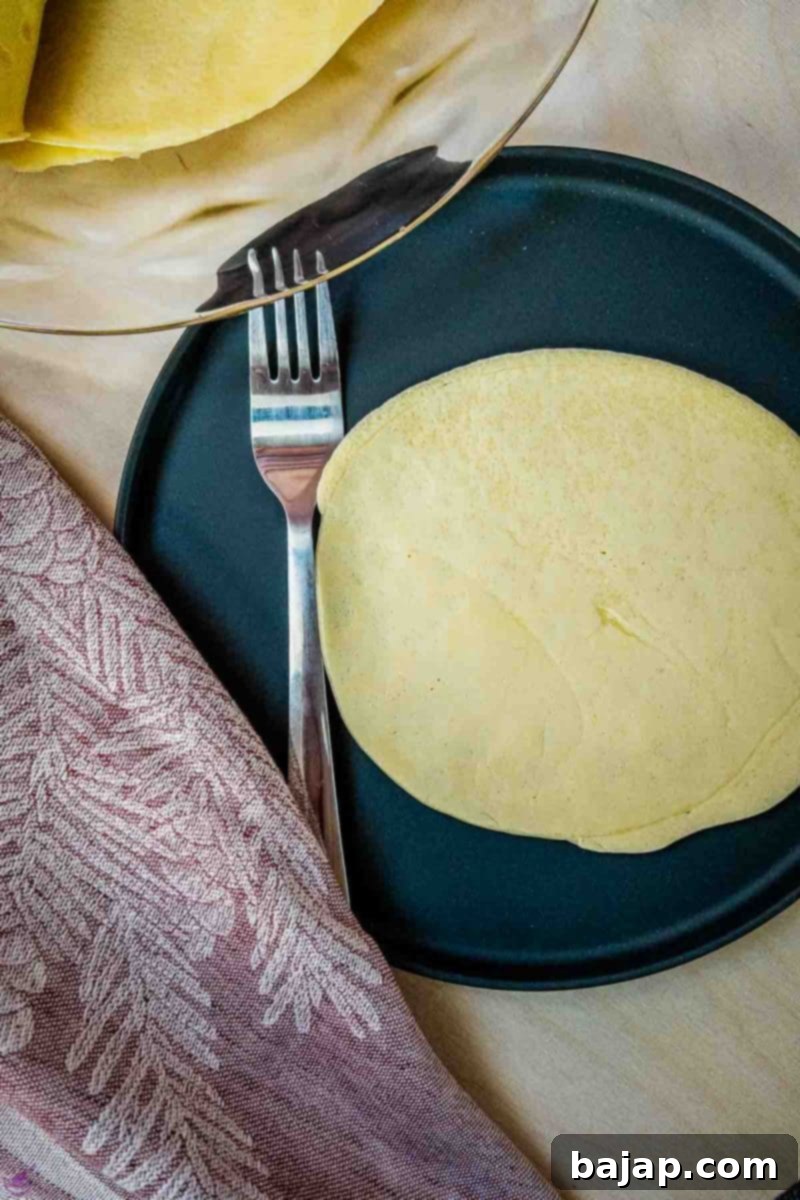
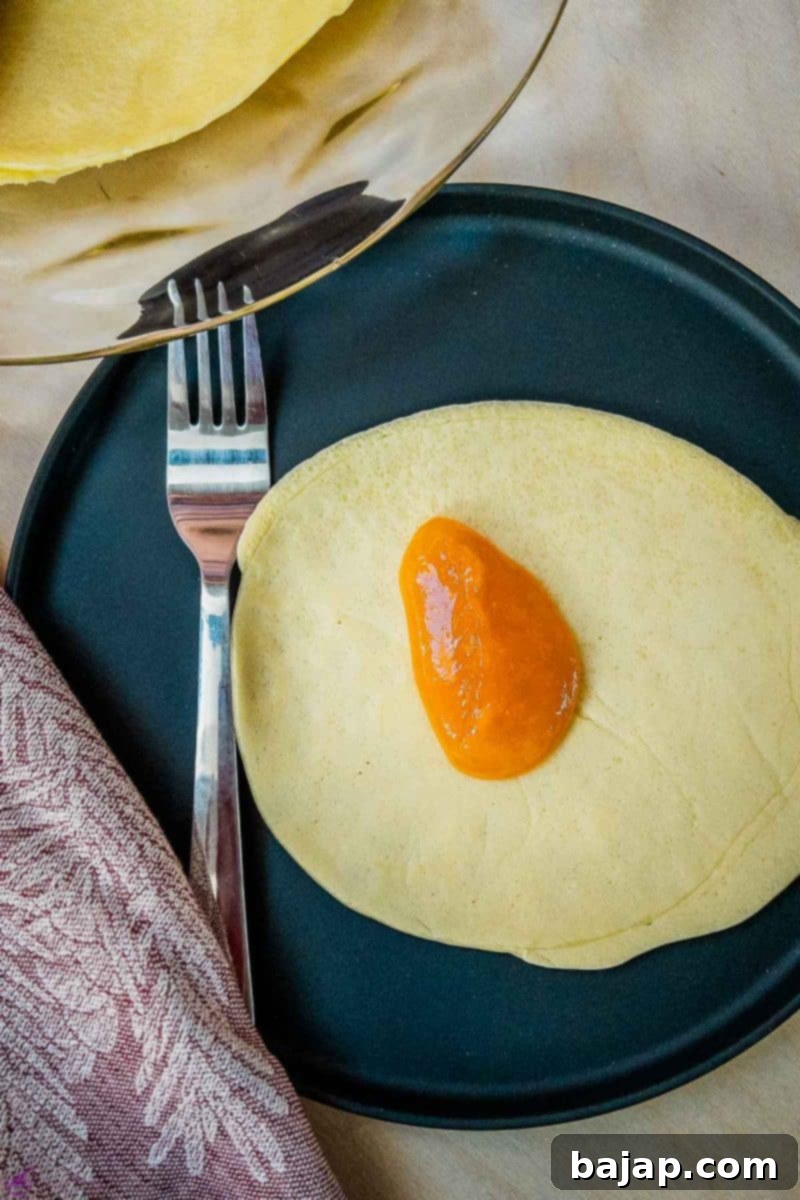
Take each warm, freshly fried pancake, lay it flat on a clean surface, and spread a spoonful of the prepared apricot jam evenly across its entire surface, leaving a small border around the edges. Then, carefully and gently roll up each jam-filled pancake into a neat, tight cylinder. The warmth of the pancake will slightly melt the jam, creating a perfectly gooey, sweet, and comforting filling as you roll.
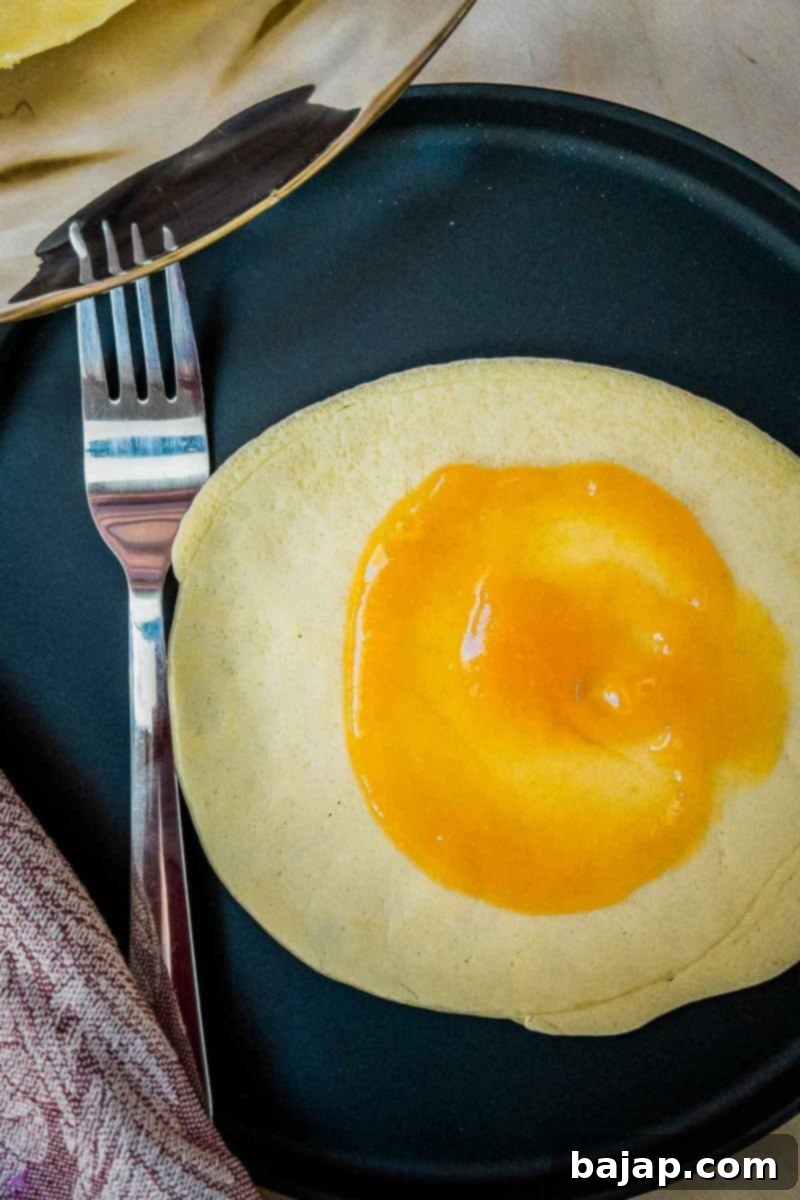
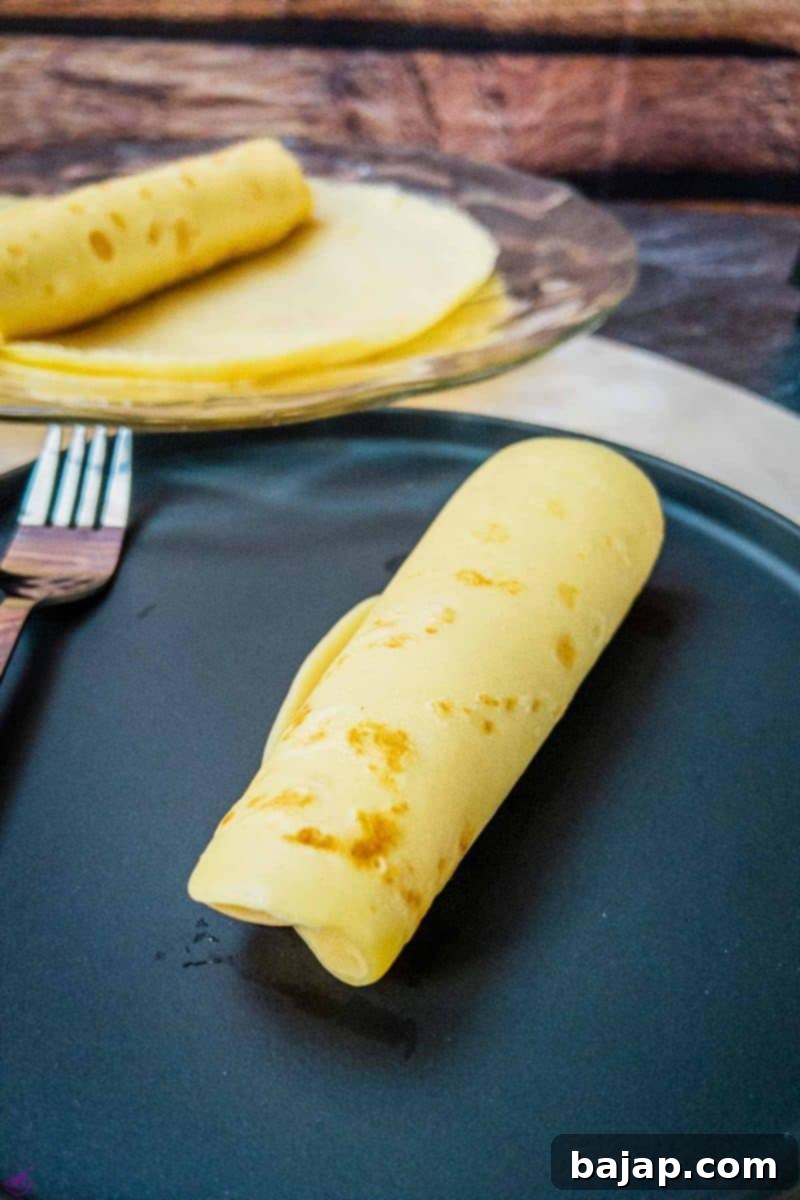
Finally, arrange your neatly rolled Palatschinken on a serving plate. For the classic presentation, dust them generously with a fine layer of powdered sugar. Serve them warm immediately after dusting to enjoy the delightful contrast of the warm, delicate pancake, the sweet and tangy jam, and the cool, ethereal powdered sugar. This simple yet elegant dessert is simply irresistible and embodies the charm of Austrian culinary tradition!
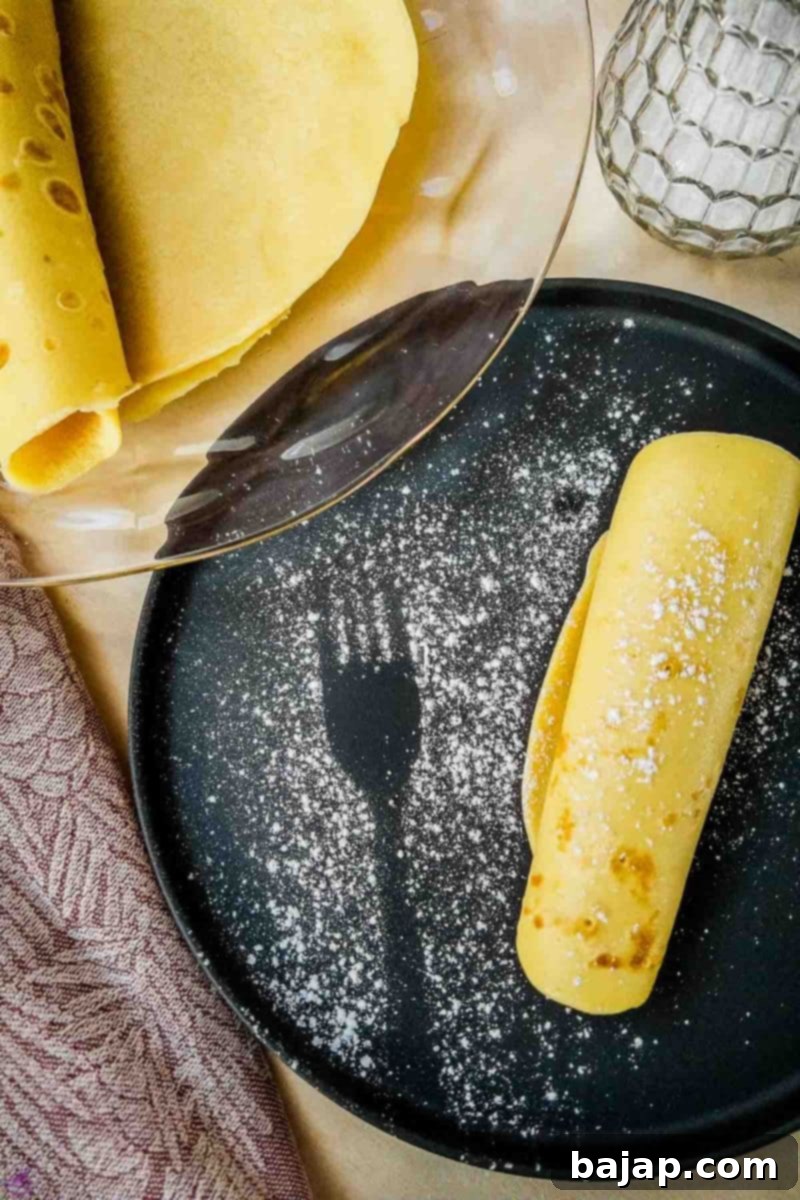
🍑 Delicious Variations on Palatschinken
While apricot jam Palatschinken are a beloved classic for good reason, these delicate thin pancakes are incredibly versatile and invite endless creativity! Don’t be afraid to experiment with different fillings to suit your mood, seasonal availability, or dietary preferences. Here are some inspiring ideas for delicious variations:
- Beyond Apricot Jams: Expand your jam horizons! Explore other fruit preserves like sweet strawberry, tangy raspberry, rich cherry, or even a tart currant jam. Each offers a unique flavor profile that beautifully complements the delicate pancake. For a truly seasonal treat, try plum butter in the autumn.
- Creamy & Cheesy Fillings: For a more substantial and traditional Austrian variation, try a sweetened curd cheese (Topfen or quark) filling, often mixed with raisins, lemon zest, and a touch of vanilla. A simple whipped cream filling, or even a rich mascarpone cream, can also create a wonderfully indulgent Palatschinken.
- Fresh Fruit Delights: Layer your Palatschinken with a medley of fresh berries (strawberries, blueberries, raspberries), thinly sliced bananas, or warm, sautéed apples and cinnamon. A sprinkle of toasted nuts like walnuts, almonds, or pecans can add a lovely textural crunch and nutty flavor.
- Chocolate Indulgence: For chocolate lovers, the possibilities are endless! Spread them with Nutella, a rich chocolate ganache, or a simple homemade chocolate sauce. Add some chopped toasted hazelnuts for a delightful Ferrero Rocher-inspired treat, or shaved dark chocolate for a touch of bitter contrast.
- Savory Adventures: Don’t limit Palatschinken to just sweets! They make a fantastic base for savory meals as well. Fill them with flavorful ingredients like sautéed spinach and feta cheese, thinly sliced ham and melted Gruyère, or a creamy mushroom ragout. These savory variations are often briefly pan-fried again after filling until heated through and golden.
- Ice Cream Extravaganza: For a truly decadent dessert experience, fill warm Palatschinken with your favorite flavor of ice cream (vanilla bean or pistachio are excellent choices!). Drizzle generously with chocolate sauce or caramel, and top with a dollop of whipped cream and sprinkles for a celebratory treat.
Unleash your culinary imagination! Whether you prefer sweet or savory, a classic preparation or an experimental twist, Palatschinken provide the perfect canvas for your creativity. If you discover a truly fabulous creation or a unique combination you adore, please share it with us! Tag @combinegoodflavors on social media and use the hashtag #combinegoodflavors – I’d absolutely love to see and be inspired by your unique culinary masterpieces!
🍽 Essential Equipment for Palatschinken
Having the right tools can make the process of creating perfect Palatschinken even smoother and more enjoyable. While many items are standard kitchen staples, a few specialized pieces can greatly enhance your pancake-making experience. Here’s a list of essential kitchen equipment we recommend:
- Food Processor or Whisk: For smoothly combining the batter ingredients without any stubborn lumps. An electric stand mixer or hand mixer also works perfectly for achieving that silky-smooth consistency.
- Coated Pan (or non-stick crêpe pan): A good quality non-stick surface is absolutely crucial for preventing the delicate Palatschinken from sticking and ensuring they can be easily flipped without tearing. A dedicated crêpe pan, with its shallower edges, can make the swirling and flipping process even easier.
- Spatula: A thin, wide, and flexible spatula is ideal for gently loosening the edges of the pancake and carefully sliding underneath to flip the delicate Palatschinken without causing any damage.
- Medium Mixing Bowl (with a pouring spout): A bowl with a convenient pouring spout is highly recommended. It allows for easy and controlled pouring of the thin batter into the hot pan, which is essential for achieving an even, thin layer.
- Close-meshed Sieve: This is a key tool for two reasons: primarily, to strain the pancake batter for a super smooth, lump-free consistency, and secondarily, it’s handy for pressing the apricot jam through if you desire an extra-fine, seedless filling.
🌡 Storage Tips for Your Palatschinken
Palatschinken are not just incredibly delicious when freshly made; they also store remarkably well, making them an excellent candidate for advance preparation, meal prepping, or simply having a sweet treat readily available whenever a craving strikes. If you find yourself with extra batter or cooked pancakes, here’s how to store them effectively to maintain their quality and flavor:
- Refrigerating Uncooked Batter: Any leftover uncooked batter can be perfectly stored in an airtight container in the refrigerator for up to 2-3 days. Before you plan to use it again, give the batter a good whisk, as the flour might have settled. You may also need to add a splash more milk to achieve the desired thin consistency again, as the batter can thicken slightly when chilled.
- Refrigerating Cooked Pancakes: Cooked and cooled Palatschinken can be stacked neatly with a sheet of parchment paper placed between each one to prevent them from sticking together. Store them in an airtight container in the refrigerator for up to 3-4 days. To reheat, you can gently warm them in a pan over low heat or briefly in the microwave until they are warm and pliable again.
- Freezing Cooked Pancakes: This is perhaps the best news for any Austrian pancake enthusiast! Finished Palatschinken freeze beautifully and can maintain their delicious quality for up to six months. This makes them perfect for batch cooking. I highly recommend doubling or even tripling the recipe when you make them, and then freezing a batch of these delightful delicacies for future enjoyment. You’ll thank yourself later for having a quick, gourmet dessert on hand!
A practical freezing tip: Once your cooked Palatschinken are completely cooled, stack them neatly, ensuring you place a sheet of parchment or baking paper between each pancake. This crucial step prevents them from freezing into a solid block. Form a small “tower” of pancakes, then carefully place this stack into a large freezer bag or an airtight freezer-safe container. When you’re ready to enjoy them, simply remove the desired number of pancakes from the freezer. Allow them to thaw slightly at room temperature or in the refrigerator, then reheat gently in a pan or microwave until they are warm, soft, and ready to be filled or re-filled with your favorite jam.
💭 Expert Tips for Frying and Turning Pancakes
To ensure a frustration-free pancake frying experience and achieve perfectly golden, delicate Palatschinken every single time, pay close attention to these key tips and techniques:
- Always use a non-stick pan: This is a non-negotiable requirement for making thin pancakes like Palatschinken. A good quality non-stick surface is absolutely essential to ensure the pancakes don’t stick, cook evenly, and can be easily loosened and flipped without tearing.
- Don’t over-oil the pan: Use only a very minimal amount of oil or melted butter for each pancake – just a drop or a tiny swipe. The goal is to lightly grease the surface, not to fry the pancake in excess fat. Too much oil will result in greasy, heavy pancakes that lack that delicate, airy texture and will certainly not taste as delicious or authentic. If you accidentally add too much, simply wipe out the excess with a paper towel.
- Gently loosen the edges: When the first side of the pancake is cooking over medium heat, regularly use your spatula to gently separate the edges of the pancake from the pan. This anticipatory step prevents them from sticking firmly and makes it significantly easier to slide your spatula completely underneath the pancake when it’s time to flip. Look for the edges to start browning and slightly curling away from the pan as a sign it’s ready.
- The confident flip: The pancake should be turned in one swift, confident, and decisive motion. Unless you are a seasoned professional who can gracefully toss pancakes in the air (and even then, practice caution!), it’s best to avoid such theatrics. Before attempting to turn, carefully slide a wide, thin, and flexible spatula completely under the pancake, ensuring it is fully supported across its width to prevent any tearing. Then, with a quick, confident wrist flick, lift and flip it over. Cook the second side until it also achieves a beautiful golden brown color, then carefully remove it from the pan.
- Regulate heat consistently: Pay close attention to your pan’s temperature throughout the cooking process. If your pancakes are browning too quickly on the outside while remaining undercooked inside, lower the heat slightly. Conversely, if they are cooking too slowly or not achieving that desirable golden-brown color, increase the heat marginally. Maintaining a consistent medium heat is key to evenly cooked, perfectly colored Palatschinken.
🎉 Don’t forget, September 26th is National Pancake Day! A truly perfect occasion to indulge in these delightful and traditional Austrian Palatschinken! 🥳
If you make this delightful Palatschinken recipe, I would absolutely love to hear from you! Please let me know how you liked it by giving it a ★★★★★ star rating and leaving a comment below. Your feedback is incredibly invaluable and truly appreciated, helping other home cooks discover this wonderful recipe! You can also stay updated with our latest delicious homemade recipes and culinary inspirations by signing up for our Newsletter. For more culinary inspiration and to share your wonderful creations, follow me on Pinterest or Instagram. Remember to tag me @combinegoodflavors and use the hashtag #combinegoodflavors so I don’t miss seeing your culinary masterpieces!
Frequently Asked Questions about Palatschinken
- What is the main difference between Palatschinken and French crêpes?
- While both Palatschinken and French crêpes are indeed thin pancakes, there are subtle differences. Palatschinken are typically slightly thicker than crêpes and often feature a richer batter due to the inclusion of extra egg yolks, which also gives them a more vibrant golden color. They are traditionally rolled with sweet fillings, most famously apricot jam, and served as a dessert or sweet main course. Crêpes, on the other hand, can be even thinner, often served folded, and are popular with a wider array of sweet or savory fillings.
- Can I make Palatschinken batter ahead of time?
- Absolutely! Preparing the batter in advance is a fantastic time-saver, especially if you’re planning to serve them for breakfast or brunch. Store the mixed batter in an airtight container in the refrigerator for up to 2-3 days. Before using, give it a good whisk, as the flour can settle at the bottom. You might also find it has thickened slightly in the cold, so be prepared to add a touch more milk to achieve the desired thin, pourable consistency.
- What other fillings are popular for Palatschinken besides apricot jam?
- The versatility of Palatschinken is one of their greatest charms! Beyond the classic apricot jam, popular sweet fillings in Austria include sweetened cottage cheese (known as Topfenpalatschinken), chocolate sauce or Nutella, various fruit compotes (such as plum, cherry, or berry), or fresh fruits served with whipped cream. For savory Palatschinken, common and delicious fillings include sautéed spinach and feta cheese, ham and cheese, or creamy mushroom fillings. Feel free to get creative with your favorite combinations!
- How do I prevent my Palatschinken from tearing when flipping?
- Preventing tears is key to perfect Palatschinken! Several factors contribute to a successful flip:
- Batter Consistency: Ensure your batter is thin enough but not excessively watery. A properly rested batter, where the gluten has relaxed, is also less prone to tearing.
- Pan Temperature: Make sure your pan is heated to a consistent medium temperature. If the heat is too low, the pancake might stick; if it’s too high, it can become brittle and tear easily.
- Non-Stick Surface: A good quality, well-seasoned non-stick pan is paramount. If your pan isn’t perfectly non-stick, lightly grease it for each pancake.
- Spatula Technique: Use a thin, wide, and flexible spatula. Gently loosen the edges of the pancake from the pan first. Then, confidently slide the spatula completely under the entire pancake, ensuring it’s fully supported before making a swift and decisive flip. Avoid rushing the process, and let the pancake cook sufficiently on the first side before attempting to turn.
📖 Recipe Card: Thin Pancakes with Apricot Jam (Palatschinken)
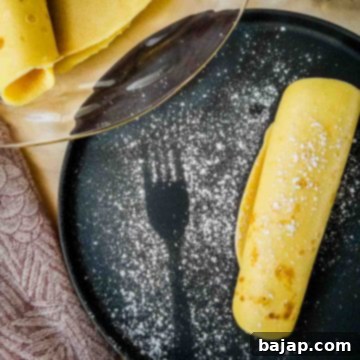
Thin Pancakes with Apricot Jam
Nora
Save RecipeSaved!
Pin Recipe
Equipment
-
Kitchen machine or electric whisk
-
Non-stick Frying Pan or Crêpe Pan
-
Flexible Spatula
-
Mixing cup or mixing bowl (with beak for pouring)
-
Fine-meshed Sieve
